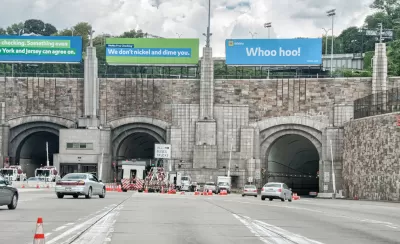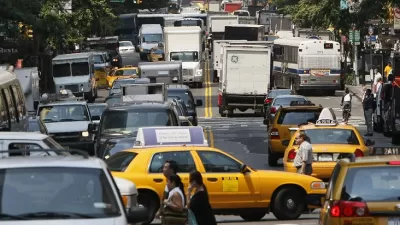Almost half of New Yorkers would drive less if a long-awaited congestion pricing plan is implemented in Manhattan, according to a recent poll.

A recent NY1/Sienna College Poll found that New Yorkers intend to respond to congestion pricing in exactly the way one would expect: by driving less and taking more transit trips.
“Some 42% of New Yorkers said they would get behind the wheel less and 64% would switch over to subways and buses should the government start tolling motorists,” writes Kevin Duggan to report the survey findings for AMNY.
The congestion pricing scheme under consideration for New York City would enact “cordon pricing” in Manhattan south of 60th Street. The plan has been on a rollercoaster for years, however—failing in the New York State Legislature in 2008, then winning approval in 2019 and facing delays delayed first by the Trump administration and then the Covid-19 pandemic. The Environmental Assessment for the plan is expected in December 2022. Current New York Governor Kathy Hochul has not been strongly supportive of congestion pricing in recent weeks.
More coverage of the poll can be found in an article by Clayton Guse for the New York Daily News.

Trump Administration Could Effectively End Housing Voucher Program
Federal officials are eyeing major cuts to the Section 8 program that helps millions of low-income households pay rent.

Planetizen Federal Action Tracker
A weekly monitor of how Trump’s orders and actions are impacting planners and planning in America.

The 120 Year Old Tiny Home Villages That Sheltered San Francisco’s Earthquake Refugees
More than a century ago, San Francisco mobilized to house thousands of residents displaced by the 1906 earthquake. Could their strategy offer a model for the present?

HSR Reaches Key Settlement in Northern California City
The state’s high-speed rail authority reached an agreement with Millbrae, a key city on the train’s proposed route to San Francisco.

Washington State Legislature Passes Parking Reform Bill
A bill that would limit parking requirements for new developments is headed to the governor’s desk.

Missouri Law Would Ban Protections for Housing Voucher Users
A state law seeks to overturn source-of-income discrimination bans passed by several Missouri cities.
Urban Design for Planners 1: Software Tools
This six-course series explores essential urban design concepts using open source software and equips planners with the tools they need to participate fully in the urban design process.
Planning for Universal Design
Learn the tools for implementing Universal Design in planning regulations.
Ada County Highway District
Clanton & Associates, Inc.
Jessamine County Fiscal Court
Institute for Housing and Urban Development Studies (IHS)
City of Grandview
Harvard GSD Executive Education
Toledo-Lucas County Plan Commissions
Salt Lake City
NYU Wagner Graduate School of Public Service





























